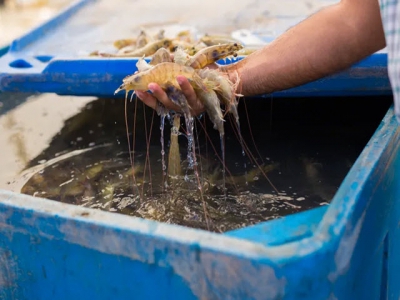Biomass - the billion-dollar shrimp question - Part 1

As part of the on-going series on The Fish Site, the shrimp farming experts at Alune outline the current techniques for measuring shrimp biomass and explain how emerging technologies can give producers accurate estimates without compromising shrimp welfare.
Shrimp farmers should calculate the total biomass of shrimp ponds at harvest to see how accurate their estimates were. Photo: XpertSea
Why accurate biomass estimates matter
“How many chickens do I have?” What may seem an easy question for a chicken farmer is a puzzling question for a shrimp farmer. In livestock farming, farmers have a direct visual, 3D interaction with all of their animals. With this easy visibility, they can acquire crucial data – weight, survival rate, health and stress levels of the population – at low or no cost. For shrimp farmers, this is not the case. Shrimp live on the bottom of ponds, out of sight and beyond easy reach.
Farming efficiency requires information and today the most important, unsolved data point in shrimp farming is biomass. Biomass data is crucial for calculating the average daily growth (ADG), feed conversion ratio (FCR) and probiotic regime. Biomass data also plays a critical role in farm management decisions, such as harvest time and disease identification. Currently shrimp farmers rely on manual sampling methods for estimating biomass. However, these have low accuracy and induce stress in the shrimp, as well as being labour intensive.

Despite the need for accurate biomass estimates, most shrimp farmers rely on manual methods which are less accurate. Photo: Kurt Servin
To address this, *Alune’s farming team have designed four biomass estimation operating procedures. The farming team are also testing their own novel, low-tech invention which costs less than $15 USD. Many more technologies are emerging which we will discuss here.
What is biomass?
Shrimp biomass is the number of shrimp alive (Survival Rate/SR) times the weight of the shrimp (Mean Body Weight/MBW). Shrimp biomass is different from total pond biomass, which includes all microorganisms within the pond. Understanding the number of shrimp alive in a pond is the most complex part of calculating biomass, as shrimp distribution is unequal and depends on feeding and pond conditions.
With accurate biomass information farmers are better able to adjust feed regimes to maximise growth and minimise costs, with positive environmental and shrimp health impacts. At times of stress, such as during a disease outbreak, ammonia build-up or harvesting, understanding mortality rates and growth is vital to making feed and harvesting decisions.
The cost of inaccurate biomass estimation is high. Although no shrimp-specific data is available, a ±5 percent error on biomass estimation has caused a loss of €91 million every year for the European fish farming industry. Assuming a similar ±5 percent inaccuracy in biomass (which is optimistic), $500 million USD is being lost by shrimp farmers every year, or 65,000 tonnes of protein wasted. The real impact is likely higher than this.
In 2019, the market for precision aquaculture is estimated to be valued at $398 million and projected to reach $764 million by 2024. Aquaculture must shift to a more knowledge-based approach to achieve this, and the problem of biomass estimation is at the core of this shift. Various studies and technology companies are racing to crack the billion-dollar question.

Inaccurate biomass estimates can cost shrimp farmers millions in lost revenue. Photo: Gurvinder Singh
Biomass estimation today
Despite the importance of biomass, farmers have a limited toolkit to obtain biomass data, with growth measured from a sample of the population and survival rate measured using cast nets and/or feed trays. This manual approach relies on broad population distribution assumptions and is highly labour intensive. However, it remains the industry standard for biomass estimation today.
Stocking biomass
Establishing the number of post-larvae (PL) stocked sets the benchmark for the cycle, on to which all adjustments are made. It is common for hatcheries to provide up to 30 percent more PL than needed to account for mortality during transport and to boost perceived performance. PL counting is usually done by hand, counting a selection of the PL in their bags to estimate the average number per bag. Algebae and XpertSea offer two non-manual solutions to completing this step. Weighing and measuring variation of PL is also important to establish health and initial stocking biomass.

Many shrimp farmers estimate biomass when they're transferring post-larval shrimp between ponds. Photo: Tarah Mayes
Có thể bạn quan tâm
 How to handle ammonia spikes when farming shrimp - Part 1
How to handle ammonia spikes when farming shrimp - Part 1 Ammonia is nitrogenous waste produced from feed input and microbial decomposition of organic matter in water columns.
 How to handle ammonia spikes when farming shrimp - Part 2
How to handle ammonia spikes when farming shrimp - Part 2 In order to prevent ammonia issues in shrimp ponds, proper management is needed to keep the concentration below the maximum threshold or lethal concentrations.
 Study backs the use of bacteriophages in shrimp aquaculture
Study backs the use of bacteriophages in shrimp aquaculture Bacteriophages can prove an effective alternative to the use of antibiotics to tackle Vibrio infections in shrimp aquaculture, according to a new study.